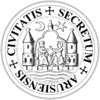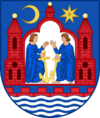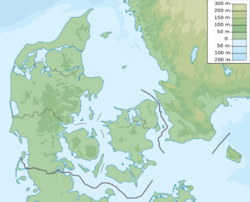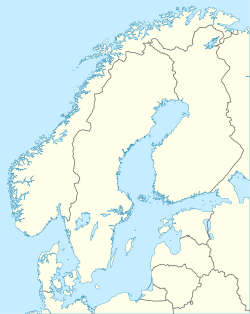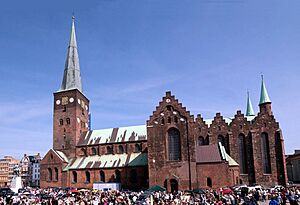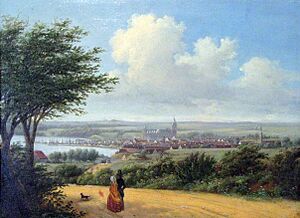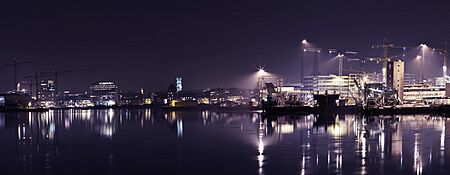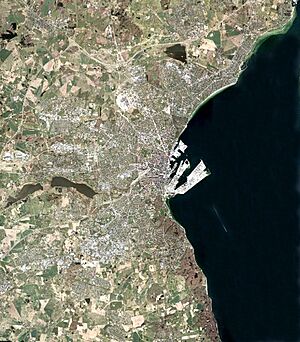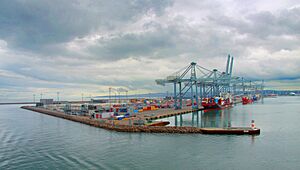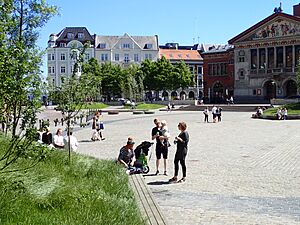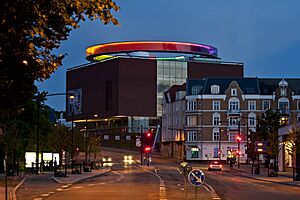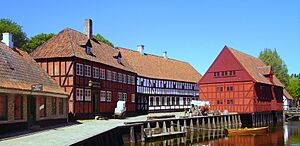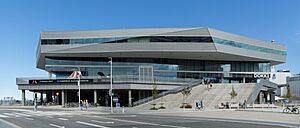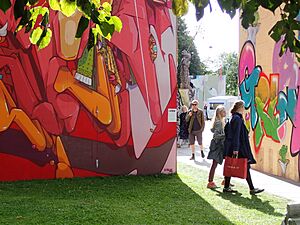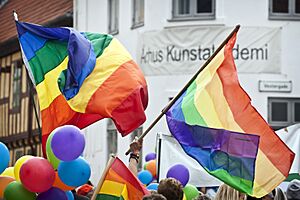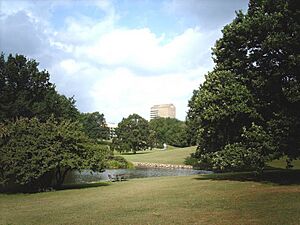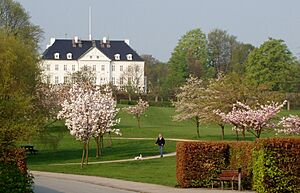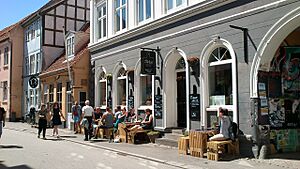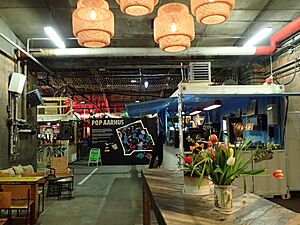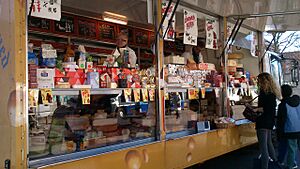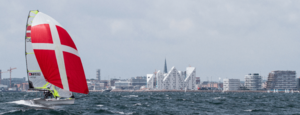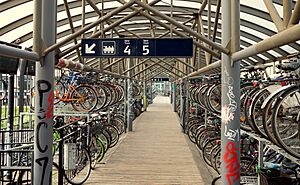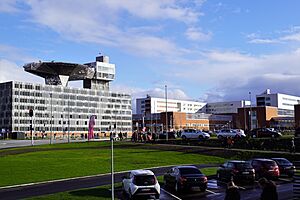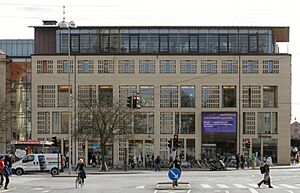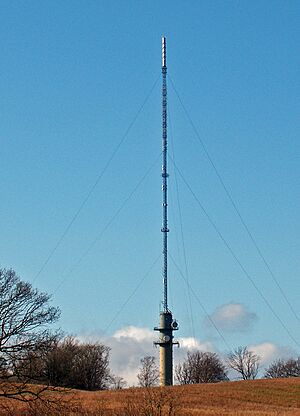Aarhus facts for kids
Quick facts for kids
Aarhus
|
|||
|---|---|---|---|

From top and left to right: Aarhus skyline, Aarhus City Hall, Isbjerget, Park Allé
|
|||
|
|||
| Nickname(s):
Smilets by (City of smiles)
|
|||
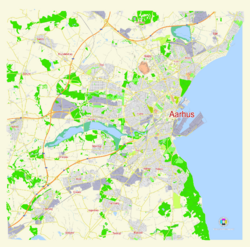
Aarhus Denmark Street Map
|
|||
| Country | Denmark | ||
| Region | Central Denmark Region (Midtjylland) | ||
| Municipality | Aarhus | ||
| Established | 8th century | ||
| City Status | 15th century | ||
| Named for | Aarhus River mouth | ||
| Government | |||
| • Type | Magistrate | ||
| Area | |||
| • Urban | 99.4 km2 (38.4 sq mi) | ||
| • Municipal | 468 km2 (181 sq mi) | ||
| Highest elevation | 105 m (344 ft) | ||
| Lowest elevation | 0 m (0 ft) | ||
| Population
(1 January 2024)
|
|||
| • Rank | Denmark: 2nd | ||
| • Urban | 295,688 | ||
| • Urban density | 2,975/km2 (7,710/sq mi) | ||
| • Municipal | 367,095 | ||
| • Municipal density | 784/km2 (2,030/sq mi) | ||
| Demonym(s) | Aarhusianer | ||
| Time zone | UTC+1 (CET) | ||
| • Summer (DST) | UTC+2 (CEST) | ||
| Postal code |
8000, 8200, 8210, 8220, 8230
|
||
| Area code(s) | (+45) 8 | ||
Aarhus is the second-largest city in Denmark. It is located on the eastern coast of Jutland, a large peninsula. The city sits by the Kattegat sea. It's about 187 kilometers (116 miles) northwest of Copenhagen, Denmark's capital.
Aarhus began as a harbor town in the late 700s. It was built where the Aarhus River meets the sea. It quickly became an important place for trade. The first Christian church was built around 900 AD. During the Viking Age, the town was protected by strong walls.
Over time, Aarhus grew steadily. In 1441, it officially became a market town. The city really started to grow in the 1800s with the Industrial Revolution. The first railway line in Jutland was built here in 1862.
Today, Aarhus is a big university city. It's the main center for trade, services, industry, and tourism in Jutland. It's known as Smilets By (City of Smiles). Aarhus has the youngest population in Denmark. It is also home to Scandinavia's largest university, Aarhus University. Many big Danish companies, like Vestas (wind turbines) and Arla Foods (dairy), have their main offices here.
Contents
- What's in a Name?
- A Look Back: History of Aarhus
- Where is Aarhus? Geography and Climate
- Who Lives in Aarhus? Demographics
- How Aarhus Makes Money: Economy
- Cityscape: A Mix of Old and New
- Culture and Fun in Aarhus
- Sports in Aarhus
- Learning in Aarhus: Education
- Getting Around: Transport
- Staying Healthy: Healthcare
- News and Information: Media
- Global Connections: International Relations
- Notable people
- See also
- Images for kids
What's in a Name?
Aarhus gets its name from two old Norse words. These are ár (meaning "river") and oss (meaning "mouth"). This describes the city's location. It sits right where the Aarhus River flows into the sea.
How the Name is Spelled
The city's name has changed spelling over time. In 1948, a Danish spelling reform changed "Aa" to "Å". So, Aarhus became Århus. However, in 2010, the city council decided to change it back to Aarhus. This change took effect on January 1, 2011.
Even though the official spelling is Aarhus, you might still see Århus sometimes. Some older institutions, like the local newspaper Århus Stiftstidende, still use the "Å" spelling.
A Look Back: History of Aarhus
Early Days: Vikings and Beyond
Aarhus is one of Denmark's oldest cities. It was founded during the early Viking Age. The first settlement, called Aros, was right where the city center is now. It was by the mouth of the Aarhus River. This was a good spot for sea trade. It was located on important trade routes.
Archaeologists have found signs that Aarhus was a town as early as the late 700s. They've found old houses, tools, and even a shipbuilding yard from the Viking Age. In the early 900s, the town was protected by strong earth walls. These were possibly ordered by King Gorm the Old. Later, his son Harald Bluetooth made these defenses even stronger. This shows that Aros became an important military center.
The first Christian church in Aarhus was built around 900 AD. The city became a bishopric (an area led by a bishop) by 948. Even with attacks, like one around 1050, Aarhus continued to grow through trade. In 1060, a new stone church, Sankt Nicolai Domkirke, was built.
Medieval Times: Churches and Trade
During the Middle Ages, the Church became very powerful in Aarhus. Many religious buildings were constructed. Aarhus Cathedral, a very impressive church, was started in the late 1100s. Around 1200, Aros had a total of four churches.
In 1441, Aarhus was officially given "market town" status. This was done by King Christopher III. This was a big step, recognizing the town's importance in the region. As the town grew, its old Viking walls were removed in 1477. This made space for the city to expand. You can still see parts of these old defenses in street names like Volden (The Rampart) and Graven (The Moat). By the early 1500s, Aarhus had become one of the largest cities in Denmark.
In the 1600s, Aarhus faced some tough times. It suffered from wars with Sweden. Trade also slowed down. But by the mid-1700s, things improved. This was largely due to trade with the surrounding farms, especially grain. The first factories started to appear as the Industrial Revolution began. In 1810, the harbor was made bigger to handle more trade.
Growing Up: Industrial Revolution and Modern Times
Aarhus really started to boom in the 1830s. Factories with steam-powered machines became more common and productive. The city council worked quickly to improve the harbor. In 1840, the harbor was moved to the coast. It became the largest industrial harbor outside Copenhagen.
Even with wars and occupations in the mid-1800s, the city kept growing. In 1862, Jutland's first railway line was built. It connected Aarhus and Randers. This helped the city become a major industrial center. Many new industries started, especially those processing farm products. These included oil and butter. Famous companies like Ceres Brewery (1856) and Arla Foods (started as a butter exporter) began here.
By the early 1900s, Aarhus was the largest city in Denmark outside Copenhagen. Its population grew from 15,000 in 1870 to 52,000 in 1901. New neighborhoods were built. Many cultural places were also established. These included Aarhus Theatre (1900) and Aarhus University (1928).
World War II and After
During World War II, Nazi Germany occupied Aarhus from 1940 to 1945. The city's port became important for German supplies. Danish resistance groups formed. In October 1944, the Royal Air Force bombed the Gestapo headquarters in Aarhus. This helped destroy important records. The war ended in May 1945.
After the war, in the 1970s and 1980s, Aarhus saw fast economic growth. More people started working in services rather than factories. The number of students tripled. This made Aarhus a big center for research and education. This also led to a creative period. Many Danish rock and pop bands started in the city.
Aarhus in the 2000s
Since 2000, Aarhus has had a huge building boom. Many new buildings, roads, and city areas have been created. For example, the old docklands are being turned into new neighborhoods. These new areas include homes and businesses. This is one of the biggest harbor development projects in Europe.
The city also built Aarhus Letbane, Denmark's first light rail system. It opened in 2017. It connects the city center to other areas and towns. More routes are planned for the future. Aarhus continues to grow quickly. The city aims to have 375,000 residents by 2030.
Where is Aarhus? Geography and Climate
City Landscape
Aarhus is located on the Bay of Aarhus. This bay faces the Kattegat sea to the east. The bay provides a natural harbor. Aarhus was founded at the mouth of a brackish water fjord. This original fjord no longer exists. It has gradually become the Aarhus River and the Brabrand Lake.
The land around Aarhus is hilly. It was formed by glaciers during the last ice age. You can find forests like Marselisborg Forest and Riis Skov. These are located on the hills along the coast to the north and south. The highest point in Aarhus Municipality is Jelshøj. It is 128 meters (420 feet) above sea level.
Weather in Aarhus
Aarhus has a mild, oceanic climate. This means the weather can change a lot throughout the year. Summers (June to August) are warm. Winters (December to March) are cooler, often with frost and sometimes snow. Spring (April and May) is mild. Autumn (October and September) can be rainy and windy.
The average temperature for the year is about 8.43°C (47.17°F). The Bay of Aarhus helps keep the city's central valley mild.
Who Lives in Aarhus? Demographics
Aarhus has a population of about 295,688 people in its urban area. This was recorded on January 1, 2024. The whole municipality has about 367,095 residents. The population of Aarhus is younger and more educated than the average in Denmark. More than 40% of the people have a university degree. The largest age group is 20- to 29-year-olds. This makes Aarhus the youngest city in the country.
The city is home to many different religious groups. Most are Christian or Muslim. There are also smaller Buddhist, Hindu, and Jewish communities. The majority of the population are members of the Protestant state church, the Church of Denmark.
Aarhus has a diverse population. Many people have roots outside Europe. The largest groups come from the Middle East and North Africa. Others have come from within Europe, like Poland and Germany.
| Nationality | Population in 2017 | Population in 2023 |
|---|---|---|
| 5,030 | 5,240 | |
| 4,554 | 4,905 | |
| 4,370 | 4,362 | |
| 3,688 | 3,916 | |
| 2,577 | 3,043 | |
| 2,551 | 2,578 | |
| 2,261 | 2,551 | |
| 2,235 | 2,672 | |
| 2,092 | 2,591 | |
| 1,983 | 2,678 |
How Aarhus Makes Money: Economy
Aarhus's economy is mostly based on knowledge and services. It is strongly influenced by Aarhus University. The large healthcare industry also plays a big role. The service sector is growing as the city moves away from manufacturing. Trade and transportation are still important. This is thanks to the large port and central position on the rail network.
The municipality has about 175,000 jobs. About 100,000 of these are in the private sector. Many people commute to Aarhus from nearby towns. Aarhus is a major retail center in the Nordic and Baltic countries. It has large shopping centers and busy commercial streets.
The wind power industry has strong roots in Aarhus. Most of Denmark's wind industry revenue comes from companies in the greater Aarhus area. The biotech industry is also well-established. It has many small and medium-sized companies focused on research. Several Big Tech companies, like Uber and Google, have offices here.
Several major companies have their headquarters in Aarhus. These include Arla Foods (one of Europe's largest dairy groups). Also, Salling Group (Denmark's largest retailer) and Jysk (a worldwide retailer of household goods). Vestas (a global wind turbine maker) and Terma A/S (a defense manufacturer) are also based here.
Aarhus Port: A Busy Hub
The Port of Aarhus is one of the largest industrial ports in northern Europe. It has Denmark's largest container terminal. This terminal processes over 50% of Denmark's container traffic. It can handle the largest container vessels in the world. The port handles about 9.5 million tonnes of cargo each year. Grain is the main export. Animal feed, stone, cement, and coal are major imports.
The ferry terminal offers a way to travel between Jutland and Zealand. Mols-Linien operates this route. It transports about two million passengers and a million vehicles annually. The port has also become a popular stop for cruise ships visiting the Baltic Sea.
Tourism: What to See and Do
The ARoS Art Museum, the Old Town Museum, and Tivoli Friheden amusement park are among Denmark's top tourist attractions. They attract almost 1.4 million visitors combined. Other popular places include Moesgård Museum and Kvindemuseet (the Women's Museum).
The city's extensive shopping facilities are also a major draw for tourists. Festivals, especially NorthSide and SPOT, are also popular. Many visitors arrive on cruise ships.
In the 2010s, tourist facilities expanded significantly. This included new hotels. Many visitors are Danes from other regions. Others come mainly from Norway, Sweden, northern Germany, and the United Kingdom. They spend a lot of money in the city each year. Tourists choose Aarhus for its culture, family vacations, or as part of a trip in Denmark.
Research and Innovation
The largest research park in Aarhus is INCUBA Science Park. It focuses on IT and biomedical research. It aims to connect public institutions with new startup companies. Another major center is Agro Food Park. This park helps companies and public institutions work together on food science and agriculture.
Aarhus is also home to the Aarhus School of Architecture. This is one of two places in Denmark that offers architecture degrees. Several large architecture firms are also based here. Together, these organizations create a unique hub of architecture knowledge. The School of Architecture will get new buildings in the future Freight Station Neighborhood.
Cityscape: A Mix of Old and New
Aarhus has developed over many centuries. You can see different architectural styles from the Viking Age to modern times. The city grew around its main transport hubs: the river, the harbor, and later the railway station. Because of this, the oldest parts are still the most central and busiest today.
Streets like Volden (The Rampart) and Graven (The Moat) show where the original Viking town's defenses were. The inner city has the oldest preserved buildings. The Latin Quarter has houses from the early 1600s. Most of the present-day city was built after the industrialization of the late 1800s. Many buildings show historicism and modernism. The building boom of the 2000s has added new neighborhoods and changed the skyline with taller buildings.
New Developments
In recent years, Aarhus has seen a high demand for housing and offices. This has led to a construction boom. The new city district of Aarhus Ø, which used to be docklands, has many new homes. These are mostly privately owned apartments. The population of Aarhus Ø grew from 5 people in 2012 to 3,940 by October 2019.
Famous Landmarks
Aarhus Cathedral (Århus Domkirke) is in the center of Aarhus. It is the longest and tallest church in Denmark. It is 93 meters (305 feet) long and 96 meters (315 feet) tall. It was first built in the 1200s as a Romanesque basilica. It was later rebuilt as a Gothic cathedral. The Aarhus Katedralskole (cathedral school) was founded in 1195. It is one of the oldest schools in the world.
Another important landmark is the Church of Our Lady (Vor Frue Kirke). It is also from the 1200s. It was built on an even older church from 1060. This makes it the oldest stone church in Scandinavia.
Marselisborg Palace (Marselisborg Slot) was designed by Hack Kampmann. It was given by the city to Prince Christian and Princess Alexandrine as a wedding present in 1898. The Aarhus Custom House (Toldkammeret) from 1898 is also a famous building by Hack Kampmann.
Tivoli Friheden (Tivoli Freedom) opened in 1903. It is the largest amusement park in the city. Aarhus Theatre from 1916 is the largest theater outside Copenhagen. The early buildings of Aarhus University, especially the main building from 1932, are known for their functionalist architecture. The City Hall (Aarhus Rådhus) from 1941 has an iconic 60-meter (197-foot) tower. It was designed by Arne Jacobsen and Erik Møller.
Culture and Fun in Aarhus
Aarhus hosts many annual cultural events and festivals. It has museums, theaters, and sports events. There is a long tradition of music from all genres. Many Danish bands have emerged from Aarhus. Libraries and cultural centers offer free opportunities for people to engage in cultural activities.
Since 1938, Aarhus has marketed itself as Smilets by (City of smiles). This has become both an informal nickname and official slogan. Other slogans have included Byen ved havet (City by the sea). Aarhus is featured in popular songs by Danish artists.
Museums to Explore
Aarhus has many museums. Two of the largest in Denmark are Den Gamle By and ARoS Aarhus Kunstmuseum. Den Gamle By (The Old Town) shows Danish townscapes from the 1500s to the 1970s. It has 75 historic buildings brought from different parts of the country.
ARoS Aarhus Kunstmuseum is the city's main art museum. It is one of the largest art museums in Scandinavia. Its collection covers Danish art from the 1700s to today. It also has international art. The iconic glass structure on the roof, Your Rainbow Panorama, offers a colorful view of the city.
The Moesgård Museum specializes in archaeology and ethnography. It has exhibits on Denmark's ancient history, including the Grauballe Man. Kvindemuseet, the Women's Museum, contains collections about the lives of women in Danish history. The Occupation Museum shows the German occupation during World War II. The Natural History Museum has 5,000 animal species. The Steno Museum is about the history of science and medicine.
Libraries and Community Spots
Public libraries in Denmark are also cultural and community centers. They host many events, exhibitions, and workshops. In June 2015, the large central library and cultural center of Dokk1 opened at the harbor front. Dokk1 aims to be a landmark and a public meeting place. Apart from this main library, some neighborhoods have local libraries.
The State Library at the university campus is a national library. Aarhus is a member of the ICORN organization. This helps provide a safe place for authors who are persecuted in their home countries.
There are several cultural and community centers throughout the city. These include Folkestedet and Godsbanen. They offer workshops, events, and activities for various groups.
Performing Arts: Music and Theatre
The city has strong musical traditions. These include classical, alternative, and popular music. Important institutions are the concert halls of Musikhuset, the opera of Den Jyske Opera, and Det Jyske Musikkonservatorium (Royal Academy of Music). Musikhuset is the largest concert hall in Scandinavia. Other major music venues include VoxHall and Train nightclub.
The acting scene in Aarhus is diverse. It has many groups and venues. They perform a broad range of genres. These include children's theater, classical theater, and improvisational theater. Aarhus Teater is the oldest and largest venue. Svalegangen is the second largest. The cultural center of Godsbanen includes several stages.
Aarhus is known for its musical history. In the 1950s, jazz clubs became popular. By the 1970s and 1980s, Aarhus became a center for rock music. It fostered bands like Kliché, TV-2, and Gnags. Famous artists like Thomas Helmig also came from here.
Events and Festivals
Aarhus hosts many annual festivals and events. The Aarhus Festuge is the most popular and wide-ranging. It is the largest multicultural festival in Scandinavia. It takes place every year for ten days in late August or early September. The inner city is transformed with festive activities.
There are many music festivals. The eight-day Aarhus Jazz Festival features jazz in many venues. It usually takes place in July. NorthSide Festival presents well-known bands every year in mid-June. It has grown to a three-day festival with 35,000 guests. Spot festival showcases new Danish and Scandinavian talents. The outdoor Grøn Koncert music festival also takes place in Aarhus.
Aarhus also hosts events for specific art genres. International Living Theatre (ILT) is a festival for performing arts. LiteratureXchange is a new annual festival focusing on literature. The city actively promotes its gay and lesbian community. It celebrates the annual Aarhus Pride festival.
Local events include the university boat-race. It is held in the University Park. Teams from university departments race in inflatable boats. The annual lighting of the Christmas lights on the Salling department store is also a big attraction.
Green Spaces and Outdoor Fun
The beech forests of Riis Skov and Marselisborg are on the hills along the coast. Sandy beaches form the coastline of the entire municipality. There are two public sea baths: Den Permanente and Ballehage Beach.
The mild climate allows for outdoor recreation all year. This includes walking, hiking, cycling, and outdoor team sports. Water sports like sailing and kayaking are also popular in the bay. Paths for pedestrians and cyclists connect the city center to the countryside.
Aarhus has many parks and green spaces, covering about 550 hectares (1,360 acres). The central Botanical Gardens (1875) are popular. They include The Old Town open-air museum. They also have a collection of trees and bushes from around the world. Recently renovated greenhouses show exotic plants.
The undulating University Park is known for its unique design. It has large old oak trees. The Memorial Park offers a panoramic view across the Bay of Aarhus. It is popular for outings and picnics. Other notable parks include the City Hall Park and Marienlyst Park.
Marselisborg Deer Park in Marselisborg Forests has 22 hectares (54 acres) of fenced woodland. It has free-roaming sika and roe deer. Below the Moesgård Museum, there is a large historical landscape. It shows different eras of Denmark's prehistory. It has reconstructed Stone Age and Bronze Age graves.
Food, Drinks, and Nightlife
Aarhus has many restaurants. They offer food from cultures all over the world. This includes Mediterranean, Asian, and international gourmet cuisine. You can also find traditional Danish food and New Nordic Cuisine. Aarhus and the Central Denmark Region were selected as European Region of Gastronomy in 2017.
Some high-end restaurants in Aarhus have received Michelin stars since 2015. These include Frederikshøj and Substans.
Street food vendors are common in the center. They often sell from small trailers. These are traditionally called Pølsevogne (sausage wagons). They serve Danish hot dogs and other fast food. There are also more options with international flavors like sushi and kebab.
The city center is full of cafés. Many are along the river and in the Latin Quarter. Aarhus Street Food and Aarhus Central Food Market are two indoor food courts from 2016. They have many street food restaurants, cafés, and bars.
Aarhus has a lively nightlife. The action is mostly in the inner city. This includes the pedestrianized riverside and the Latin Quarter. You can find everything from small, cozy places to fashionable nightclubs.
The Århus Set is a local tradition. It is a set of two drinks often ordered together. It includes a Ceres Top beer and a shot of Arnbitter. Both are originally from Aarhus. Aarhus Bryghus is a local craft brewery.
Local Dialect
The Aarhus dialect is called Aarhusiansk (Aarhusian). It is a Jutlandic dialect. It is traditionally spoken in and around Aarhus. Like most local dialects in Denmark, its use has decreased. However, it is still strong among older people. Some common Aarhusian words are træls ('tiresome') and noller ('silly' or 'dumb').
Sports in Aarhus
| Club | Sport | League | Venue (capacity) | Founded | Titles | Attendance |
|---|---|---|---|---|---|---|
| Aarhus Gymnastikforening | Soccer | Superliga | Ceres Park (20,032) | 1880 | 5 | 23,990 |
| Aarhus GF Håndbold | Handball | Danish Handball League | Ceres Arena (4,700) | 2001 | 9 | 4,700 |
| Bakken Bears | Basketball | Danish Basketball League | Vejlby-Risskov Hallen (1,800) | 1962 | 16 | 2,500 |
Aarhus has three major men's professional sports teams. These are the Superliga team Aarhus Gymnastikforening (AGF) for soccer. Also, Danish Handball League's Aarhus GF Håndbold for handball. And Danish Basketball League's Bakken Bears for basketball. The five sailing clubs often win national and international titles. The future national watersports stadium will be in the Aarhus Docklands.
The municipality actively supports sports organizations. It aims to attract major sporting events. Soccer is by far the most popular sport. It is followed by gymnastics, handball, and badminton.
In recent decades, many free public sports facilities have appeared. These include places for street football, basketball, climbing walls, skateboarding, and beach volley. Natural sites also offer green exercise. They have equipment along paths and tracks for mountain biking.
Aarhus has hosted many sporting events. These include the 2010 European Women's Handball Championship. Also, the 2014 European Men's Handball Championship. It hosted the 2013 Men's European Volleyball Championships. Aarhus is an important qualifier for the 2020 Olympics in sailing.
Learning in Aarhus: Education
Aarhus is the main center for education in the Jutland region. It attracts students from a large area. The high number of young people and students creates a natural base for cultural activities. Aarhus has the most students in Denmark. About 12% of its citizens are studying. The city is home to more than 52,000 students.
Since 2012, Aarhus University (AU) has been the largest university in Denmark. It is ranked among the top 100 universities in the world. The university has about 41,500 Bachelor and Master students. It also has about 1,500 PhD students. You can study many subjects here. These range from natural science and humanities to engineering and dentistry.
Aarhus Tech is one of the largest technical colleges in Denmark. It teaches undergraduate programs in English. Business Academy Aarhus is a large business academy. It offers degrees in IT, business, and technical fields. The Danish School of Media and Journalism (DMJX) is the oldest and largest journalism school. It has about 1,700 students.
The Royal Academy of Music in Aarhus is a music school. It offers graduate-level studies. These include music teaching and professional musicianship. VIA University College offers over 50 higher education courses. The Aarhus School of Architecture was founded in 1965. It is responsible for educating architects in Denmark.
Getting Around: Transport
Aarhus has two ring roads. Ring 1 goes around the central district. Ring 2 is further out. Six major motorways connect the city center to nearby cities.
In the inner city, car traffic is highly controlled. Larger parts are for pedestrians only. A system of roads for cyclists has been built. These connect to suburban areas.
The main railway station in Aarhus is Aarhus Central Station. It is in the city center. DSB has connections to destinations throughout Denmark. It also has services to Flensburg and Hamburg in Germany.
Aarhus Letbane is a local electric tram-train system. It opened in December 2017. It connects the central station and inner city to the University Hospital. It also replaced local railway services to Grenaa and Odder. It is the first electric light rail system in Denmark. More routes are planned for the future.
Most city bus lines go through the inner city. They pass through either Park Allé or Banegårdspladsen. Regional and inter-city buses stop at Aarhus Bus Terminal. FlixBus provides long-distance buses to other cities in Denmark and Europe.
Ferries run by Mols-Linien transport passengers and vehicles. They travel between Aarhus and Sjællands Odde on Zealand. These ferries include the world's largest diesel-powered catamarans.
Aarhus Airport is on Djursland, 40 kilometers (25 miles) northeast of Aarhus. It has flights to Copenhagen and international destinations. The larger Billund Airport is 95 kilometers (59 miles) southwest of Aarhus. A small seaplane operates four flights daily between Aarhus harbor and Copenhagen harbor.
Aarhus has a free bike-sharing system, Aarhus Bycykler. Bicycles are available from April to October. You can get a bike by putting a DKK 20 coin in a slot. The coin is returned when the bike is returned.
Staying Healthy: Healthcare
Aarhus is home to Aarhus University Hospital. It is one of six Danish "Super Hospitals." It was officially established in 2007. The university hospital is the result of several mergers. It is now the largest hospital in Denmark. It has about 10,000 staff and 1,150 patient beds. It has been ranked the best hospital in Denmark since 2008. A new large hospital building, Det Nye Universitetshospital (DNU), was built. It brings all the former departments together.
Private hospitals also operate in Aarhus. They specialize in areas like plastic surgery and fertility treatments. The Aarhus Municipality also offers specialized services. These include nutrition, exercise, and health courses.
News and Information: Media
The first daily newspaper in Aarhus was Århus Stiftstidende. It was established in 1794. Today, the daily newspaper of Jyllands-Posten is also published in Aarhus. It has a section called JP Aarhus for news in and around Aarhus.
Danmarks Radio (DR) has a large department in Aarhus. It runs the DR Østjylland radio program. It also produces local regional television programs. In 1999, TV 2 moved its Jutland headquarters to Aarhus. It broadcasts regional news and current affairs. Aarhus has its own local TV channel, TVAarhus. It has been transmitting since 1984.
The Danish School of Media and Journalism (Danmarks Medie- og Journalisthøjskole) is the country's largest and oldest school of journalism. It has over 1,700 students. The school works closely with Aarhus University.
Global Connections: International Relations
Aarhus is home to 32 consulates:
Aarhus practices twinning with other cities. For the twin towns, see twin towns of Aarhus Municipality.
Notable people
See also
 In Spanish: Aarhus para niños
In Spanish: Aarhus para niños
Images for kids


